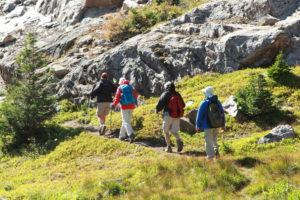When people find out that we plan trips to Peru, 90% of the time the first follow-up question is “How do people handle the altitude?”
Unfortunately there isn’t one simple fix to guarantee you won’t get altitude sickness. We have had ultra-marathoners get terrible altitude sickness while self-described “couch potatoes” feel no effects of elevation at all. It’s impossible to know how your body is going to react once it gets to a high elevation. The good news is, through trial and error, we have been able to come up with 5 recommendations that really help

combat symptoms and let you focus on the important task at hand – enjoying your vacation. Please note – we’re not doctors – just people who have seen many travelers kick altitude sickness out of their systems. The advice below comes from our experience only and isn’t meant to replace any advice you might get from a medical professional. OK – here we go!
First thing’s first – What is altitude sickness exactly?
When your body gets to 5000 feet above sea level, it starts to recognize that the air is thinner and you’re no longer able to take in as much oxygen with each “normal” breath. Your body compensates for this loss of oxygen by increasing your heart rate and working harder to pump the blood through your system. If that isn’t enough fun for you, the high elevation also causes your sweat to evaporate faster so you really can’t tell how hard your body is working and losing water. Sounds great, right?
In its simplest form, altitude sickness, also known as Acute Mountain Sickness (AMS) occurs when your body adjusts too slowly or is unable to adjust to the lower oxygen levels. You become dehydrated and your brain functions dilate to gather more oxygen which causes your brain to swell – basically giving you a headache. Left untreated or if your body is unable to adjust after 2-3 days, it can become much more intense or dangerous, but typically if you follow our tips below, you’ll be over your headache and ready for action in no time.
Tip # 1: HYDRATE! Your body is working hard and your sweat is evaporating. Replenish your fluids regularly throughout the day. Plan to drink 1 to 1.5 liters of water per day above what you would normally drink at home. Avoid drinks that dehydrate you like coffee and alcohol. You don’t have to avoid everything for the whole trip, just the first day or 2 while your body is adjusting. Stick with the local coca tea, water, or Gatorade until you feel like your normal self.
Tip # 2: EAT! Pack snacks or take advantage of the large portion sizes in restaurants. Once you get around 12,000 feet, it’s better to pack in the carbs during the day and go wild. Eat foods you enjoy to make sure you’re eating enough. The altitude will suppress your appetite so you want to try to load up when you’re hungry during the day and avoid large meals at night. We also suggest keeping coca candy or chewy candy like Starburst on hand that will take a little longer to consume. Your body needs the sugar and it will keep your saliva flowing so your lips don’t dry out.
Tip #3: PROTECT YO’ FACE! At 10,000 feet, you will be much closer to the sun. Sun burn = skin dehydration – which is not great when you’re trying to combat altitude sickness. Cover up your skin as much as possible with sleeves, pants, and hats and make sure to pack on the SPF to any exposed skin (at least SPF 30).

Tip #4: PACK MEDS! Ibuprofen has been proven to be the best over-the-counter medication to combat altitude sickness so it’s good to bring some with you if you can. If you’re really concerned, talk to your doctor about some of the other medications available today like Diamox which is supposed to help stimulate your breathing and circulate the oxygen if your body is slow to adjust. Just be sure to read about the potential side effects before taking any medication.
Tip #5: EXERCISE! Do some cardio prep before you get here. You do not have to be in the best shape of your life to complete any tour or trek in Peru, but it will help you combat altitude sickness if you exercise a bit before you get here. Try High Intensity Interval Training (HIIT), walking/jogging/running as much as possible, and taking the stairs as much as you can to prepare for your trip. Any effort you put in before the trip will only help you in the long run. Improving cardio fitness will help your body recover faster and adjust when it’s feeling deprived of oxygen at the high altitude.
Final thoughts: At the end of the day, the best we can do to prevent altitude sickness is to listen to our bodies. If you get here and you don’t feel well, sit down. Take a break. Drink some water. Take in the view or snap some photos. Respect the time it will take your body to get itself back in its comfort zone. We plan each of our tours and treks so you have time to enjoy and not rush. So sit back and trust that your body is working hard to get you back to your best self.
Have other tips or tricks that you found helpful on the trail? We’d love to hear them in the comments. Please feel free to share & stay tuned for the next blog!

